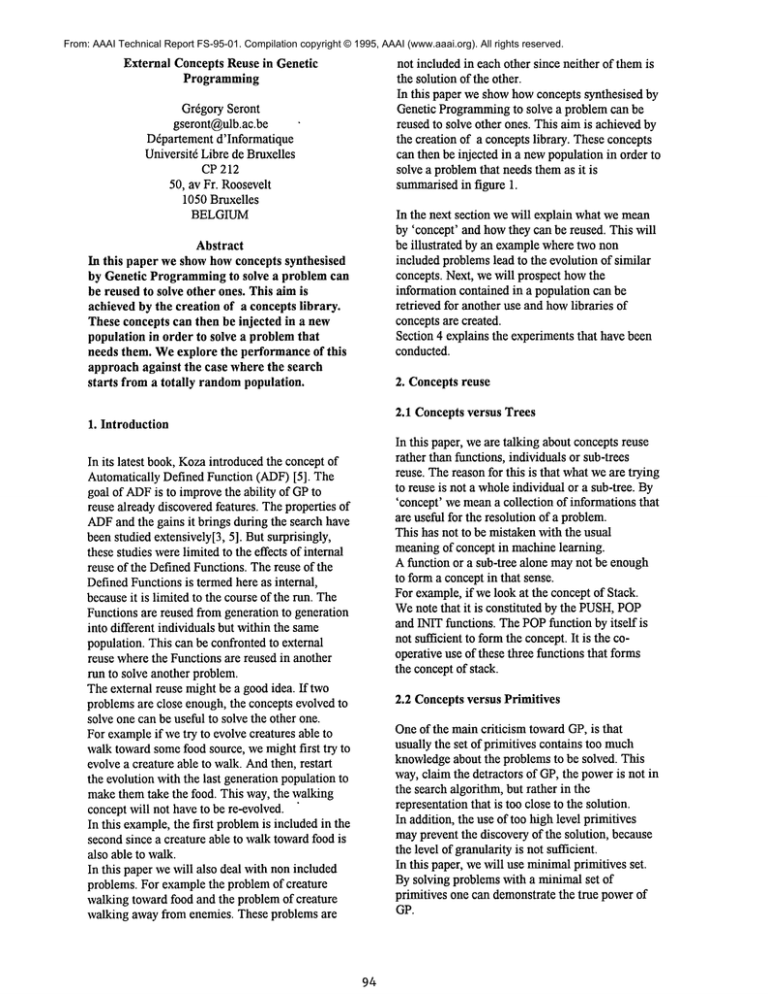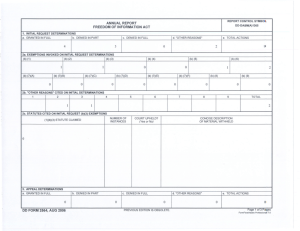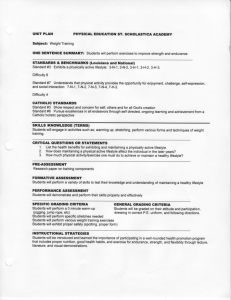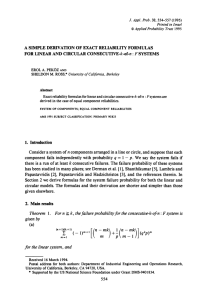
From: AAAI Technical Report FS-95-01. Compilation copyright © 1995, AAAI (www.aaai.org). All rights reserved.
External Concepts Reuse in Genetic
Programming
Gr6gory Seront
gseront@ulb.ac.be
D6partement d’Informatique
Universit6 Libre de Bruxelles
CP 212
50, av Fr. Roosevelt
1050 Bruxelles
BELGIUM
Abstract
In this paper we show howconcepts synthesised
by Genetic Programmingto solve a problem can
be reused to solve other ones. This aimis
achieved by the creation of a concepts library.
These concepts can then be injected in a new
population in order to solve a problemthat
needs them. Weexplore the performanceof this
approachagainst the case where the search
starts froma totally randompopulation.
not included in each other since neither of them is
the solution of the other.
In this paper we showhowconcepts synthesised by
Genetic Programmingto solve a problem can be
reused to solve other ones. This aim is achieved by
the creation of a concepts library. Theseconcepts
can then be injected in a newpopulation in order to
solve a problemthat needs themas it is
salmmarisedin figure 1.
In the next section we will explain what we mean
by ’concept’ and howthey can be reused. This will
be illustrated by an examplewhere two non
included problemslead to the evolution of similar
concepts. Next, we will prospect howthe
information contained in a population can be
retrieved for another use and howlibraries of
concepts are created.
Section 4 explains the experiments that have been
conducted.
2. Concepts reuse
2.1 Concepts versus Trees
1. Introduction
In its latest book, Kozaintroduced the concept of
Automatically Defined Function (ADF)[5]. The
goal of ADFis to improvethe ability of GPto
reuse already discovered features. The properties of
ADFand the gains it brings during the search have
been studied extensively[3, 5]. But surprisingly,
these studies werelimited to the effects of internal
reuse of the Defined Functions. The reuse of the
Defined Functions is termedhere as internal,
becauseit is limited to the course of the run. The
Functions are reused from generation to generation
into different individuals but within the same
population. This can be confronted to external
reuse where the Functions are reused in another
run to solve another problem.
The external reuse might be a goodidea. If two
problemsare close enough, the concepts evolved to
solve one can be useful to solve the other one.
For exampleif we try to evolve creatures able to
walk towardsomefood source, we might first try to
evolve a creature able to walk. Andthen, restart
the evolution with the last generation population to
makethem take the food. This way, the walking
concept will not have to be re-evolved.
In this example,the first problemis included in the
secondsince a creature able to walk towardfood is
also able to walk.
In this paper we will also deal with non included
problems. For examplethe problemof creature
walking toward food and the problem of creature
walking away from enemies. These problems are
In this paper, we are talking about concepts reuse
rather than functions, individuals or sub-trees
reuse. The reason for this is that whatwe are trying
to reuse is not a wholeindividual or a sub-tree. By
’concept’ we meana collection of informations that
are useful for the resolution of a problem.
This has not to be mistaken with the usual
meaningof concept in machine learning.
A function or a sub-tree alone maynot be enough
to form a conceptin that sense.
For example, if we look at the concept of Stack.
Wenote that it is constituted by the PUSH,POP
and INIT functions. The POPfunction by itself is
not sufficient to formthe concept. It is the cooperative use of these three functions that forms
the conceptof stack.
2.2 Conceptsversus Primitives
Oneof the main criticism toward GP, is that
usually the set of primitives contains too much
knowledgeabout the problems to be solved. This
way, claim the detractors of GP, the poweris not in
the search algorithm, but rather in the
representation that is too close to the solution.
In addition, the use of too high level primitives
mayprevent the discovery of the solution, because
the level of granularity is not sufficient.
In this paper, we will use minimalprimitives set.
By solving problems with a minimal set of
primitives one can demonstrate the true powerof
GP.
ProN. A
GP
,~ Solution
GP
Solution
Probl. B
Figure 1 Outline of the Concept Library System
[-5,,5]
!Length
2.3 Independentdiscovery of the array index
concept
In this section, we describe two problemsleading
to the independentevolution of the same concept:
an array index.
To be complete, we must add that ’while’ and
’assign" return the value of arg2.
As you can see, the terminals set does not include
the notion of variable nor index. Thesenotions will
thus have to be evolved.
Those two problems were run with 3 ADF’s, with
respectively 0, 1 and 2 arguments.
2.3.1 Common
context
The two problems share the same context: an array
of integer of a given size (SizeMem)that must
partially filled with a certain type of information.
Thisvectoris initially filled withall ’ 1’.
F-----T -..r
i i
,1,1,1,1
°..T----l---.r
i
!
.....
Integer constants
the numberof positions to
fill
fig. 4 Common
terminals set
2.3.2 Problem1: Zeroes
- - 1
i I
The first problemcalled ’Zeroes’ is the following:
to find a programthat fills the array, with ’Length’
consecutivezeroes, starting from the first position
in the vector.
The solution must be general for all possible value
of Length.
The fitness is defined by the following formula:
10
N#~ss=/~A.~s/gn+3.A~Trrevt-~
-A~
Tn~ze
Where,
NbAssignis the numberof positions different from
’ 1’ in the area [0, Length-ll
TreeSizeis the size of the Tree.
NbDestroyedis the numberof positions different
from’ 1’ in the area [Length, SizeMem].
NbCorrectis the numberof ’0’ in the wantedarea.
NbCorrect for the ’Grow’ problem is the numberof
positions in the wantedarea that are greater than
the precedingone (ex: 4, 8 ).
The figure 5 showsa solution for this problem.
1,
fig. 2 Initial configurationof the array
The two problems share the same terminals and
fimctions set. This set is minimalin the sense that
it is impossible to removea terminal or a function
without makingthe problem impossible to solve.
classical arithmetic
operators.
evaluate argl then arg2
while( argl, arg2
while argl is > 0
mem(argl
returns the integer at the
position(largll modulo
SizeMem)of the array
assign the value of arg2 to
assign( argl, arg2
the position (largll modulo
SizeMem)in the vector.
fig 3. Common
functions set
95
2.3.3 Problem 2: Grow
RPB:
(= (ADF1(while (= -3 ADF0)
(= ADF0
The second problemcalled ’Grow’is very close:
fill the array of integers with an increasing suite of
consecutive numbersof a given ’Length’ (ex: 4, 7,
10, 45, 48, ... ).
Thefitness is the sameas it is for ’Zeroes’except
that NbCorrectis the numberof positions in the
wantedarea that are greater than the preceding one
(ex: 4, 8, 3, 5 gives NbCorrect= 2 ).
The figure 6 showsa solution for this problem.
(mem3))))
ADF0:
(- (mere (= (mem
(mere 3)))
AI)FI:
3
ADF2:
ARG1
2.3.4 Discussion
fig. 6 a solution for ’Grow’
Wesee that we have t3vo commonconcepts
evolved: the decrease and the consultation of an
array index. This concept is build uponvery low
level operators.
Consultation
(memlength)
2.4 Conceptslibrary and concepts storing
As mentionedin the previous section, close
problemsmayinvolve the evolution of similar
concepts.
Theidea here, is to create a library that would
contain those evolved concepts.
In order to create a real library, wemust knowat
whichlevel of granularity we have to pick the
concepts up. Obviously, they are included in the
population and since in the traditional GPmodel,
there is no co-operative behaviour amongthe
individuals, we can assumethat an individual able
to solve a problemconlzin.q the concepts needed.
As it is impossible to knowwhich parts of the
individual contain interesting concepts, the proper
granularity for concept storing seemsto be the
individual.
For the sake of diversity, our library of concepts
will be constituted by a collection of individuals.
Increase
(= length ADF0)
ADFO:
(+ (memlength)
The usual solution for this problemwouldhave
beento put an ’inc’ and ’dec’ operator.
Teller showedin [ 6, 7 ], that the powerof GPis
greatly improved by the use of indexed memory
and that its mastering is of great importancefor the
future of GP.
By this example, we showthat GPis able to evolve
the needed concepts for indexed memorytreatment
from very low level operators.
It is noticeable that the notion of index have been
discovered and expressed in both cases in a very
similar form.
The fact that close problemsoften involve the
evolution of concepts close syntactically grounds
our work on External concepts reuse. If these
concepts could be transferred from one problem to
another, without having to be rediscovered,
considerable time maybe gained.
2.5 Concept sampfing
Nowthat we knowhow to store them, we have to
decide whento pick them up. Should we take them
whena totally fit individual has been found, or
before?
Intuition tells us that conceptsheld in a totally fit
individual might be overadapted to the problem
they are helping to solve, and thus lack some
generality.
The question of whenand which individual to take
remains an open question that will be explored in
next papers.
For the momentwe will build our library by taking
a copy of the whole population when some
statistical indexes are reached(see section 4.2).
RPB:
(while (ADF2ADF0-1)
(= (memlength)
ADF0:
(+ (memlength)
ADFI:
-1
ADF2:
(= length ADF0)
fig.5 a solution for ’Zeroes’
3. Library Exploitation System
Nowthat we have our library, we must knowhow
to use it in order to solve other problems.
96
tested on out of sampledata, this will insure the
generality.
Various options present themselves. The most
obviousone is to use the library to create the initial
population ’seeded’ with the concepts and
thereafter to perform a normal GPrun.
Wepresent here two seeding methods(Inject and
Shake), and another one that inject the concepts
during the run.
4.2 The problemsset
This methodgenerates the new population by
choosing randomly a given numberof individuals
fromthe library, and by filling the rest of the
population with totally randomindividuals.
The only parameter for this methodis the number
of individualsto inject.
The problemsset for the experimentsis the one
described in section 2.3. Here, we tried to evolve
solution for the problem’Grow’by reusing the
concepts evolved during the run of the problem
’Zeroes’.
The numberof operations that the programis
allowedto execute before the fitness evaluation, is
10*Length.
The raw fitness is the sumof 5 fitnesses obtained
by the formula in section 2.3 for 5 different values
of Length.
3.2 Shake
4.3 Results
This methodis less direct. The newpopulation is
created by performing totally randomcross-overs
and mutations on the library for a given numberof
generations. By totally randomwe meanthat the
candidate individuals for genetic operations are
chosen with uniform probability.
The parameters for this methodare the numberof
generation, and the probability of the different
operators.
The rationale behind this methodsis that the
individuals taken from the library are often more
fit to the newproblemthan the totally randomone.
So after a few generations, they might overcrowded
the randomones, which wouldlead to a loss of
diversity.
The experiments were conducted with a population
of 500 individuals. The selection methodwas a
tournamentof size 7.
The figure 7 showsthe results summarizedin a bar
graph. The first two bars represent respectively the
the effort for the problem’Grow’and ’Zeroes’.
Theother bars are the efforts for the different the
’Shake’ and ’Inject’ Library Exploitation Systems
with different parameters.
For the ’Shake’ method, the parameter is the
numberof generations of randomapplication of the
genetic operators. Shake = 3 meansthat the genetic
operators are applied totally randomlyfor 3
generations.
For the ’Inject’ method,the parameteris the
percentage of individuals comingfrom the library
in the initial population.
The first conclusion we can draw from these results
is that the <~ ConceptReuse>> works.The effort
needed in the worst case to find a solution has been
divided by five.
The effect of the different parametersare not clear
yet. Wecan just notice that ff the numberof
generations for ’Shake’ is too high, the results
becomeclose to those obtained with a totally
randominitial population.
Further experiments will have to be conducted to
determine the most efficient methodand to
measurethe effects of the different parameters. (
see Section 6: Future work).
3.1. Inject
3.3. Mutation
Another methodwould be to start from a random
population, and to inject the concepts during the
course of the run. The injection could be
materialised by a special mutation operator
replacing subtrees in the population by subtrees
taken from the library.
This methodis not tested in this paper.
4. The experiments
4.1 Performance Index
The measureof performanceused is the Effort as
defined by Kozain [5]. The Effort is the expected
numberof individuals to evaluate, to have a
probability z to find the solution. This effort was
computedfor z =0.99 by performing 20 runs of the
same problem with different randomseeds.
Here we consider that we have a solution if the
fitness is superior to 580 on values of Length
different fromthe training set. Since the solution is
97
Proceeedings of the second Annual Conference on
Evolutionnary Programming,La Jolla, CA:
Evolutionnary ProgrammingSociety.
[2] Collins ILL, Jefferson D.P~(1992)Anffarm:
Towardsimulated evolution, in Artificial Life 11,
Proceedingsof the Workshopon Artificial Life
Addison-Wesly, Reading, MA
[3] Kinear K.E. Jr. (1994) Alternative
Automatic Function Definition in Advancein
Genetic Programming Cambridge MA:The MIT
Press.
[4] Kinear K.E. Jr. (1993) Generality and difficulty
in Genetic Programming:Evolving a Sort in
Proceedingsof the fifth international conference
on Genetic Algorithms, S. Forest, Ed. San Mateo,
CA Morgan Kaufmann.
[5] Koza, J. R. (1994) Genetic ProgrammingII.
Cambridge MA:The MIT Press.
[6] Teller A. (1994), The Evolution of Mental
Models, inAdvance in Genetic Programming
Cambridge MA:The MIT Press.
[7] Teller A. (1994), Turing Completenessin the
Language of Genetic Programmingwith Indexed
Memory,in Proceedings of The First IEEE
Conference On Evolutionary Computation
Grow
andZeroeswith different reuse
schemes
18oooo
16oooo
14oooo
120000
I00000
8oooo
6oooo
4oo0o
20000
0
B Grow,Random
Pop
[] Zer,Random
Pop
[] Grow,
Shake
=1
E]Grow,
Shake
=2
~Grow,
Shake
=5
mGrow,
Shake
= 50
[] Grow,
Inject=3%
r~Grow,
Inject=5%
¯Grow,
bject = 10%
1
fig. 7 Experimentsresults
5. Conclusions
In this paper we introduced a newway of using the
GPparadigm. In our approach, the problem
solving does not have to start from scratch each
time. Libraries of concepts can be created and
reusedjust as it is donein the classical
programmaticparadigm. In this way, the
computationtime usually wasted to re-discover
concepts previously evolved, can be used to solve
more complexproblems. Successive layers of
increasingly complexconcepts libraries can be
build from low level operators.
Weshowedthat concepts reuse works and saves a
considerable amountof time.
6. Future Work
Several points must still be explored:
a) Whatis the comportmentof concepts reuse on
more complicated concepts involving larger trees?
b) Whichare the relative performancesof the
Shake and Inject methods?
c) Whichare the effects of the different parameters
of these methods?
Thosepoints are under study and will be the
subject of further reports.
7. Acknowledgments
I wouldlike to thank Stefan Langermanfor those
valuable hours of discussion, and AnnaShotton for
the spelling corrections.
8. References
[1] AngelineP.J., and Pollack J.B. (1993)
<< EvolutionnayModuleAcquisition >>, in
98







